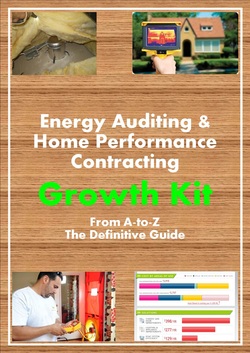Passing the BPI Exam With Energy Auditor Training
FREE BPI PRACTICE EXAMPUT YOUR HOME PERFORMANCE BUSINESS ON ROCKET FUELENERGY AUDITOR NEWSLETTERGet the only Energy Auditor Marketing Newsletter with monthly strategies and tactics to grow your home performance business.
|
BPI Written Exam - Section 2 Buildings and Their Systems
A blower door is not only useful to measure and quantify air and duct leakage but also to find where the air is entering and leaving a home through unwanted holes during installations. By pressurizing a house a crew can feel the air coming into the attic through top plate leakage around electrical wire penetrations, leaky exhaust fans, plumbing vents and open wall chases. If you are in an attic that finding the air leakage is difficult, you should consider running your blower door to locate the exact locations of leaks. At the same time you can get real time measurements of the leakage reduction and compare it to what your home's MVR is to get the home right at it's BAS sweet-spot.
During the depressurization of a home while the fan is at -50 Pa, throw your tube into a each room and shut the door as you would for a room pressure reading. Only with the blower door running you are now getting an air leakage reading relative to the room you are measuring. The higher the number, the more air sealing opportunities exist in that room. The actual number you get is not important but it should be compared to all the other rooms in the house. This way you can find if there is a particular room the crew should spend more time air and duct sealing than another. Not surprisingly the larger the room, the more leakage there will be (master bedrooms have more leakage than a guest bedroom), however you may surprise yourself. You never know until you measure. Pressure MappingWe can measure how well any area of the house (inside, attic, crawlspace or wall cavity) is connected to the outside (is outside) with pressure mapping!
Pressure mapping is a very powerful tool for complex homes with significant air leakage or older homes with enclosed attics (with vaulted ceilings and cubby holes). Here attic space is enclosed behind drywall and you can't tell if the wall cavity has been sealed off at the top plates. These homes are usually going to be balloon framing with open cavities from the basement all the way up to the attic space. A visual check in the basement will tell you if that's the case if you see lathe and plaster and open wall cavities, you've got a winner. Now you can use your blower door and knowledge of pressure mapping to determine if a wall cavity has been sealed properly or not, and where exactly you should cut drywall to access the cavity rather than cutting blindly and making a bigger mess than you have to. For a quick review, check out the section on Pressure Boundaries (1a.15). There are several ways to do pressure mapping depending on the questions you have for each home. Some tests should be done on every house, some only if you have an attached garage for example, but here is a run down of the different pressure mapping tests. All these test require a manometer and most require the use of a blower door depressurized / pressurized to 50 Pa. Rules If you know the pressure reading of one zone, you automatically know the reading of the corresponding zone. This is because we always have the blower door running at 50 Pa. It is easier for me to write this out in a formula, where: Pressure A + Pressure B = 50 Pa Pressure A is the zone that we choose to get a pressure pan reading from, whether it be an electrical outlet, a small hole we drill in a soffit, the ductwork after we tape all the registers shut and insert our tube or by removing the attic hatch (pressurize so you don't suck insulation) When measuring pressure boundaries, a zone can be any room, attic, crawlspace, outside or basement. We always measure a zone with respect to (WRT) another zone. For example we measure the room pressures of each room with respect to the outside. Zonal / zone pressure mappingThis tells us if the zone we are measuring is more inside or outside. Zones can be taken out canned lights, electrical outlets, entire rooms or by drilling a small hole in a soffit or wall cavity and sticking our tube in. 0 - 10 Pa = minimal leakage 11 - 39 Pa = confused area. Yes this is a large range but the higher you go, the more leaks or bigger the connect is to the outside 40 - 50 Pa = outside Next Section2a. Building Components
2b. Conservation Strategies
2c. Comprehensive Building Assessment Process
2d. Design considerations
|

